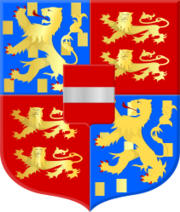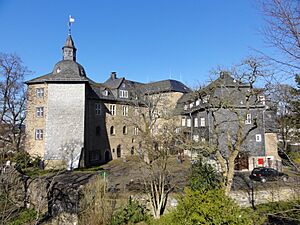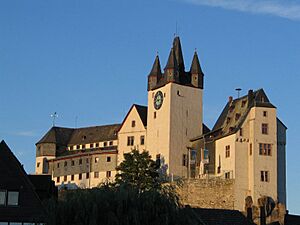Henry II, Count of Nassau-Siegen facts for kids
Quick facts for kids
Henry II, Count of Nassau-Siegen
|
|
|---|---|

Detail of the tombstone of Count Henry II of Nassau-Siegen in the Collegiata in San Quirico d'Orcia.
|
|
| Count of Nassau-Siegen Count of Vianden Count of Diez |
|
| Coat of arms |  |
| Reign | 1442–1451 |
| Predecessor | Engelbert I |
| Successor | John IV |
| Full name |
Henry II, Count of Nassau-Siegen
|
| Native name | Heinrich II. Graf von Nassau-Siegen |
| Born | Heinrich Graf zu Nassau, Vianden und Diez, Herr zu Breda 7 January 1414 |
| Died | 18 January 1451 (aged 37) Radicofani |
| Buried | Collegiata, San Quirico d'Orcia |
| Noble family | House of Nassau-Siegen |
| Spouse(s) |
|
| Issue Detail |
Ottilie |
| Father | Engelbert I of Nassau-Siegen |
| Mother | Joanne of Polanen |
Henry II of Nassau-Siegen (born January 7, 1414 – died January 18, 1451) was a powerful noble. He was a Count who ruled over Nassau-Siegen, Vianden, and half of Diez starting in 1442. His official titles were Count of Nassau, Vianden, and Diez, Lord of Breda. Henry belonged to the House of Nassau, an important family in European history.
Contents
Biography
Henry was born on January 7, 1414. He was the second son of Count Engelbert I of Nassau-Siegen and Lady Joanne of Polanen. When he was very young, a plan was made for his first marriage in 1415. This plan said he would get control of Vianden, St. Vith, and Bütgenbach.
Becoming a Count
Henry became Count of Nassau-Siegen, Vianden, and Diez in 1442. He took over after his father, Engelbert I, passed away. Henry shared this important role with his brother, John IV. However, the County of Vianden had already been promised to Henry in his marriage agreement back in 1415.
In 1442, Roman King Frederick III gave Henry control over parts of the Duchy of Cleves, the County of Mark, and the land of Dinslaken. He also received half of the County of Diez as a fief. A fief was land or a title given by a king or lord in exchange for loyalty and service.
That same year, Henry, his brother John, and their distant cousin John I, Count of Nassau-Beilstein were given Greifenstein Castle as a fief. They also received a share of the money collected from the toll in Lahnstein. In May 1443, Henry and his brother inherited more property from their uncle, Count John II.
On January 20, 1445, Henry was officially granted the County of Vianden as a fief by Archbishop Thierry II of Cologne. Later, on February 22, 1447, Henry and his brother John decided to divide their lands. Henry received the lands in Germany and three-quarters of the County of Vianden.
Dispute Over Diez County
The County of Diez was a shared property, and there was a long-running disagreement about who truly controlled it. In 1420, Henry's father and another count, Godfrey VII, had given Diez to the Archbishop of Trier, Otto. They then received it back as a fief. This meant they still managed the land but officially owed loyalty to the Archbishop.
In 1441, Roman King Frederick III confirmed this arrangement. He told Henry and Godfrey VIII (Godfrey VII's successor) that they must accept Diez as a fief from the new Archbishop of Trier, James I. The King said that if they didn't, the county would go back to the Archbishop.
Henry and Archbishop James had many discussions and court dates to try and solve this problem. The King even appointed judges, like Count Palatine Louis IV and Archbishop Dietrich of Mainz, to help settle the dispute. However, a clear solution was not found during Henry's lifetime.
After Henry's death, because he and Godfrey had not fully accepted Diez as a fief from Archbishop James, the King gave all rights to the county to the Archbishop. Finally, on November 4, 1451, Archbishop James granted the County of Diez as a fief to Henry's brother and heir, John.
Journey and Burial
In 1450, Pope Nicholas V announced a special year called a Jubilee. Many people went on a pilgrimage to Rome. Henry also went on this journey. On his way back home, he sadly passed away on January 18, 1451. He died in Radicofani, a town in Tuscany, Italy. Some historical records suggest he might have died from the plague or malaria.
Henry was buried in a church called the Collegiata in a small town named San Quirico d'Orcia. This town is about 25 kilometers north of Radicofani. It's thought that Henry might have been heading to Siena to meet King Frederick III.
Henry's tombstone is very old and worn. It shows a warrior in armor, with a sword and dagger. His feet rest on a lion. The people from his city of Diez are believed to have ordered the tombstone. The shapes of the coats of arms on the stone are unusual for Germany at that time, which might mean the tombstone was made in Italy.
Over the years, the tombstone was moved and even built into a wall to protect it. In 1928, a visitor from the Netherlands found it hard to see because of how it was placed. However, this visitor found an old record in the church that confirmed the tombstone belonged to "Henry of Nassau, Vianden and Diez."
During church restorations in 1936 and 1946, the tombstone was finally laid flat on the floor again. A skeleton believed to be Henry's was found in the church's choir. Later, a red cord was placed around the tombstone to protect it, and a Latin inscription with an Italian translation was put on the wall above it.
Marriages and Issue
First Marriage
Henry first married Countess Genoveva of Virneburg in 1435. She passed away in Breda on April 18, 1437. Her parents were Count Rupert IV of Virneburg and Countess Agnes of Solms-Braunfels. Genoveva was buried in Breda.
Henry and Genoveva had one daughter:
- Ottilie (born before or on April 18, 1437 – died July 1493). She married twice:
- In 1449 or 1450, she married Count Philip the Younger of Katzenelnbogen.
- On June 3, 1475, she married Count Oswald I of Tierstein. Oswald was a governor in different regions and a trusted advisor.
Second Marriage
Henry married again in 1440 to Lady Irmgard of Schleiden-Junkerath. She passed away sometime after 1450. Her parents were Lord John III of Schleiden-Junkerath and Countess Joanne of Blankenheim. Henry and Irmgard did not have any children together.
Sources
|
Henry II, Count of Nassau-Siegen
House of Nassau-Siegen
Born: 7 January 1414 Died: 18 January 1451 |
||
| Regnal titles | ||
|---|---|---|
| Preceded by Engelbert I |
Count of Nassau-Siegen 3 May 1442 – 18 January 1451 |
Succeeded by John IV |
| Preceded by Engelbert I |
Count of Vianden 3 May 1442 – 18 January 1451 |
Succeeded by John IV |
| Preceded by Engelbert I |
Count of Diez 3 May 1442 – 18 January 1451 |
Succeeded by John IV |
| Preceded by Engelbert I |
Lord of Breda, etc. 3 May 1442 – 22 February 1447 |
Succeeded by John IV |






